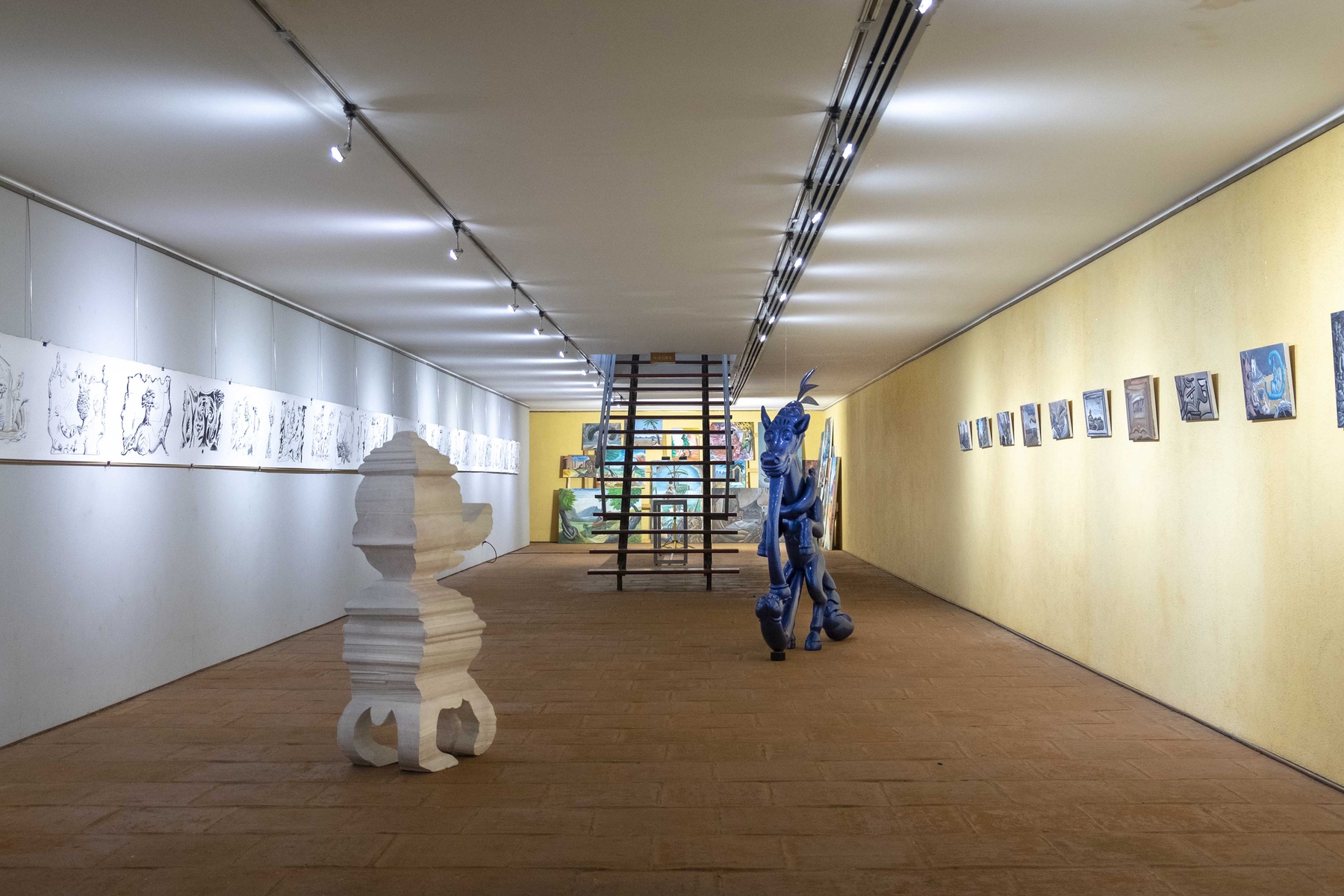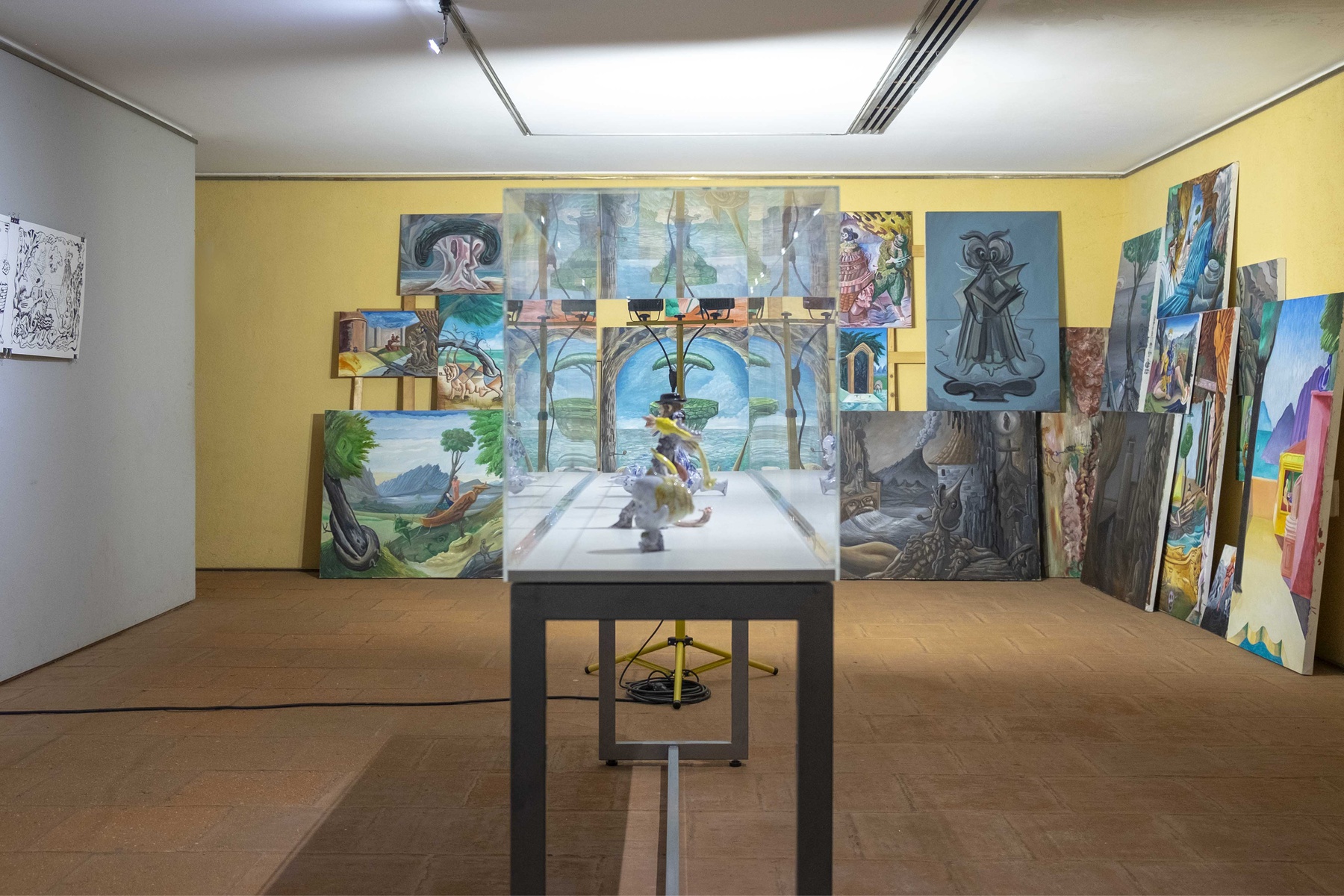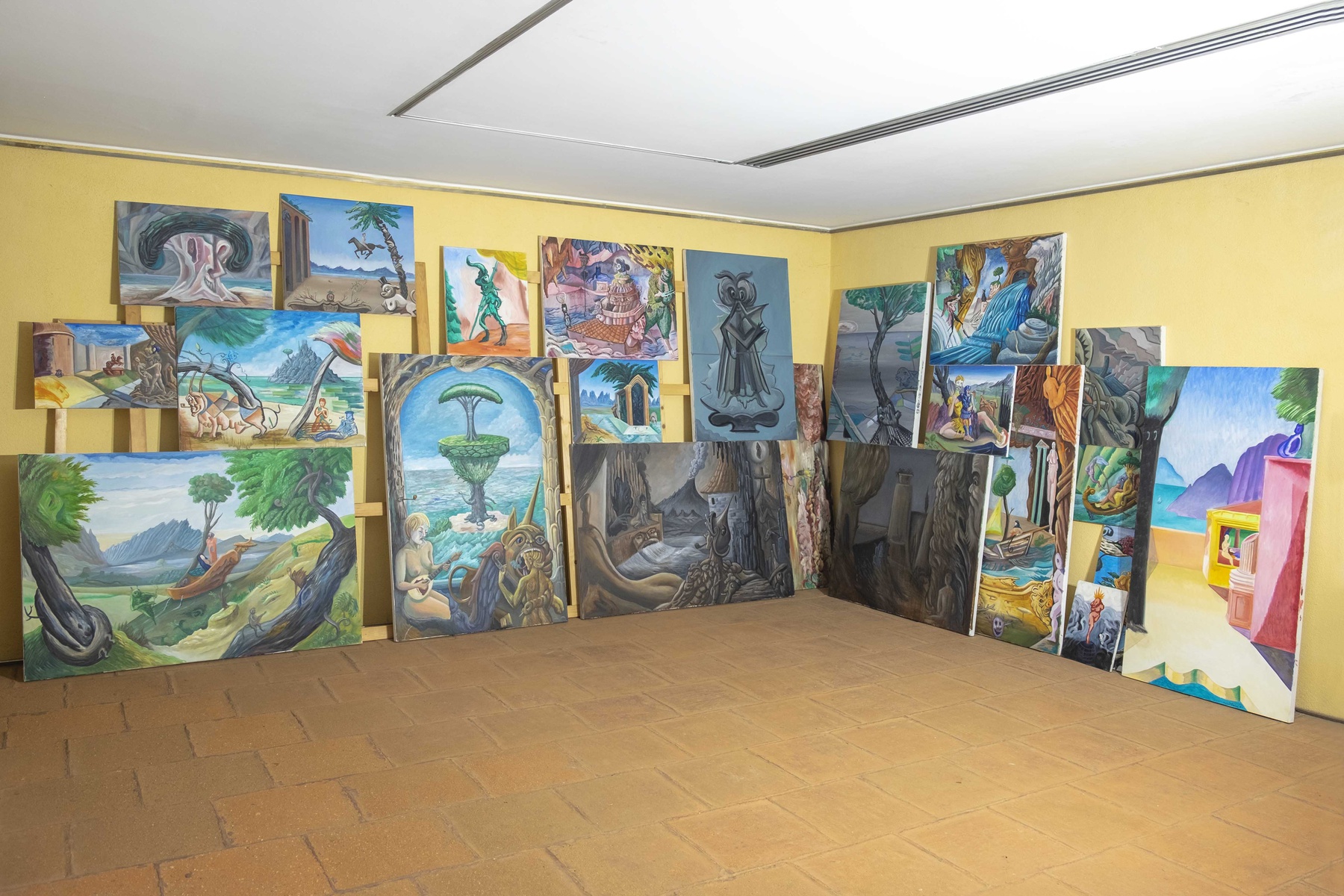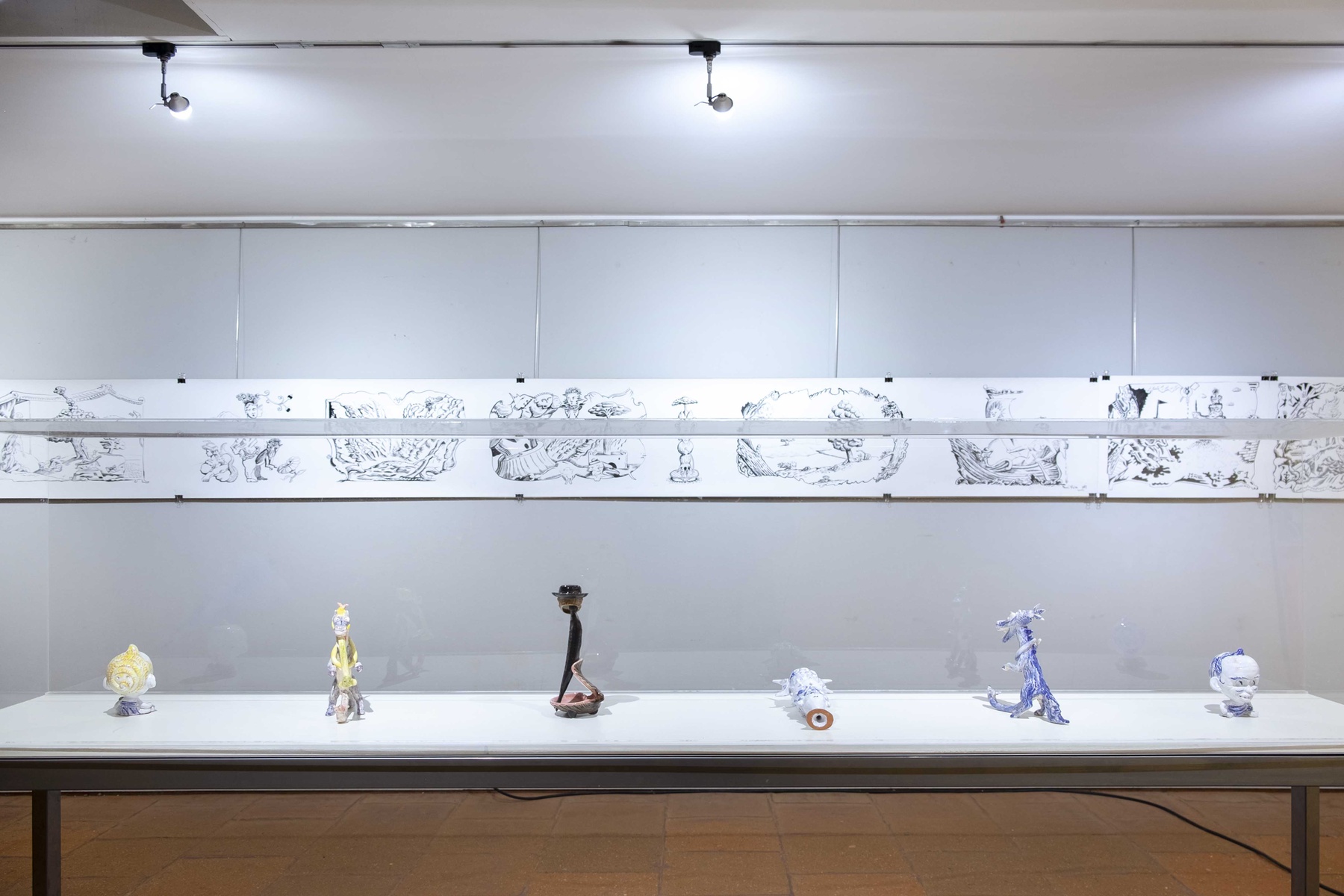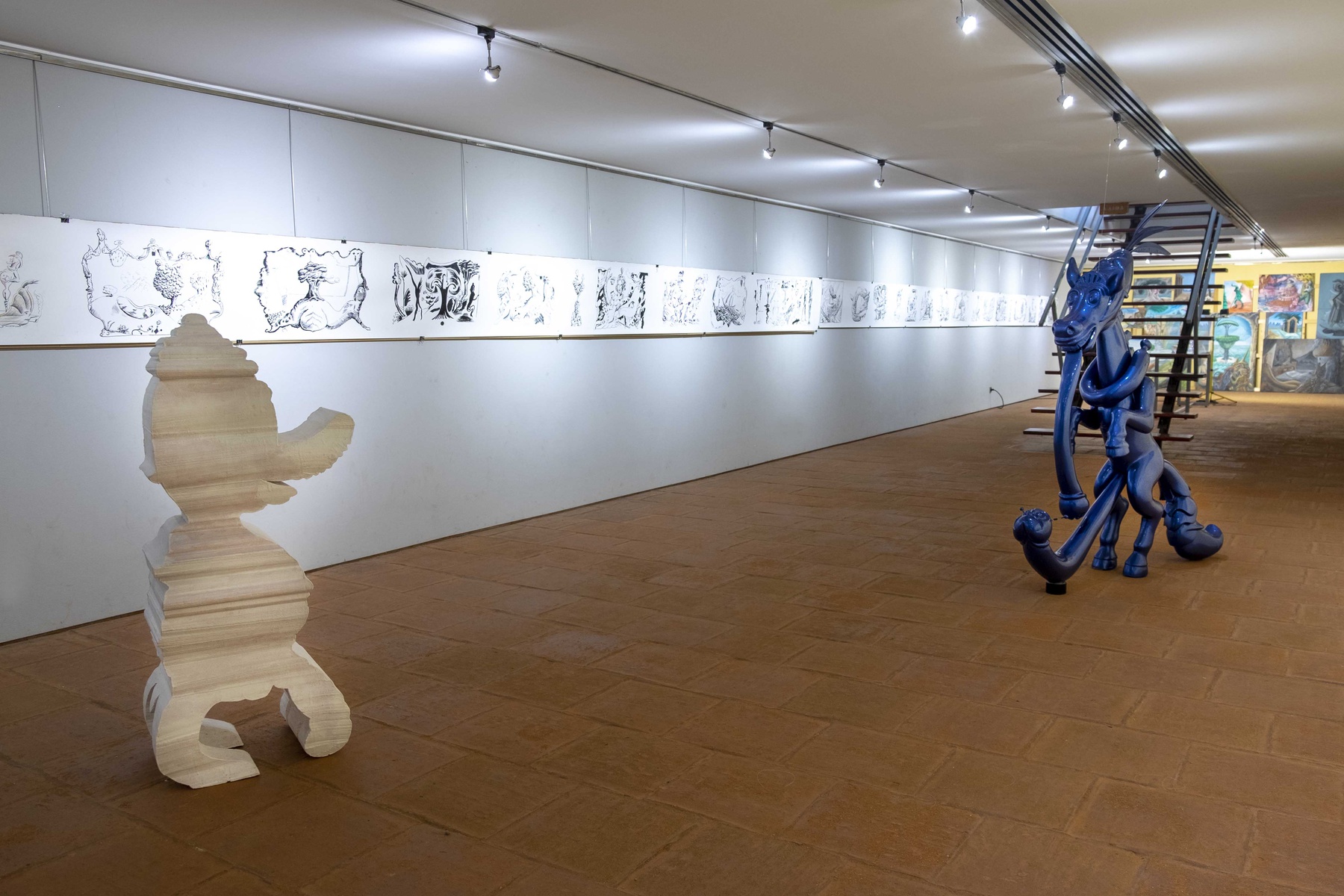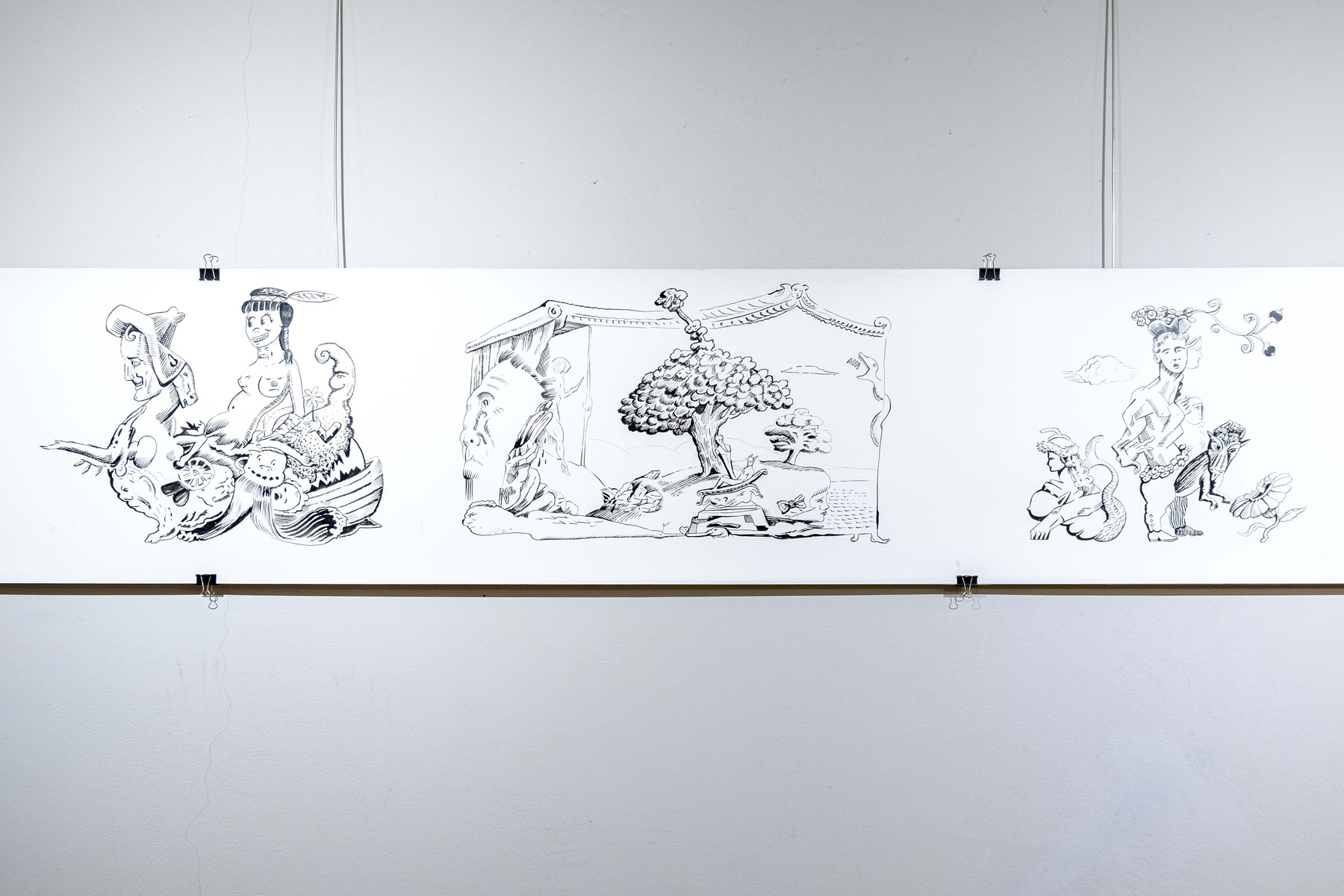Metamorphoses
Exhibition, Outside
12 Dec 2020 – 10 Jan 2021
Opening
Saturday, December 12, 10:30
Free admission
The wonderful world of Manuel Vieira
Óscar Faria
Manuel Vieira's “Metamorphoses” owe everything to Ovid. And yet, they are in no way inspired by the greatest work of this author of the 1st century. What links both names, then, that of the Lisbon artist and that of the Roman poet? The torrential imagination later poured into drawings, paintings and texts where everything seems in permanent transformation: a man changes into an animal, tree, architecture, landscape, as if such a transformation were the most natural thing in this world. We are led to believe that this is the case: fountains have mouths and a woman has a spoon for a head, as Alberto Giacometti had already taught us, Giacometti who was inspired by a ceremonial utensil of the Dan, a people from Liberia, to make, in 1926, his version of an imposing female being, a sculpture in which cubist and abstract elements are also mixed.
The woman is also celebrated in the works of Ovid and Manuel Vieira. In the case of the latter, her presence is clear in drawings and paintings in which she appears devoured by monsters, carried on the back of a horse that gallops in the sky, possible tattoo of a sailor, goddess and muse, fado singer and desired body. In the case of the Roman poet, this celebration of the feminine happens in a way that can lead us to envisage this author as a precursor of equality between the sexes. As Carlos Ascenso André notes, Ovid is “the only one among the elegiacs who insists on the idea that men must also think about the pleasure of women and not just their own”1.
The transformation of Dafne into laurel, in the first book of "Metamorphoses", at that moment when Peneus’ daughter, pursued by Apollo, almost to be reached, calls for her transformation, is described by Ovid as follows: “She had just finished her prayer/ When a heavy numbness invaded her body/ And a sheathe of bark enclosed her soft breast./ Her hair turned into fluttering leaves, her arms/ Into branches; her feet, once so swift,/ Became mired in roots, and her face was lost/ In the canopy. Only her beauty’s sheen remained”2. This mutation is just one of many that take place throughout this work and that anticipates Donna Haraway's theories by almost two thousand years, namely those related to the cyborg body or the meetings between species.
In the wonderful world of Manuel Vieira, the metamorphoses seem to have no end, whether they happen in rolls 10 meters long filled with drawings, or in one of the paintings recently finished for this exhibition. In fact, the artist went to his own collection to choose the works that best suited the theme of the cycle. And, in pursuit of that intention, he decided not only to finish some paintings that had been forgotten in some corner of his studio house, but also to carry out, over the last few months, a new body of works in which the presence of animal, vegetable and mineral elements is clear.
Thus, at Casa das Artes, we have a celebration of the History of Art centered on a figuration, related either to the fantastic, or to the theme of the landscape, or even to certain symbolic motives, such as the temple, the waterfall or the tree. In this sense, Manuel Vieira's works quote authors from Monsù Desiderio, active in the 17th century, to Walt Disney, through Fragonard, Giorgio de Chirico, Paul Klee, Magritte or even the anonymous eighteenth-century author of the engravings for “The new Justine", by the Marquis de Sade, The exhibition is thus formed by works that take us to an overflowing surrealist universe, which, in turn, welcomes other pictorial traditions, such as the romantic, the metaphysical and the abstract - there is also the evocation of the extravagant eighteenth-century “chinoiseries” and Mannerist painters, at the time considered as authors of a "decadent, repulsive and affected art, far from the canons of balance, harmony, rationality, moderation and clarity consummated in the High Renaissance by the work of artists like Rafael Sanzio and in the Michelangelo's first stage”3.
In the setup of the exhibition, we tried to take advantage of the architecture of the room. On one side, along one of the walls, there are two rolls of drawings made in 2011. Opposite, there is a set of small recent works, the “lockdown paintings", which resulted from Manuel Vieira's stay in Alentejo. The subjects are recurrent in the artist's work, and we can look at each of the works as if it were a scene from a play or even a comic opera, as it is humor, black humor, English or Vilhena-style humor, that ends up linking all the creations now disclosed at Casa das Artes.
And, among all the vices and virtues represented in the exhibition, we still have the “Wasp", a concrete, isolated element, which makes us feel its hum, its presence. Gilles Deleuze refers to that insect in a passage from the “Dialogues” with Claire Parnet. They were both talking about a “bloc of becoming”, an “a-parallel evolution”, when this luminous passage happens: “This is it, the double capture, the wasp AND the orchid: not even something which would be in the one, or something which would be in the other, even if it had to be exchanged, be mingled, but something which is between the two, outside the two, and which flows in another direction. To encounter is to find, to capture, to steal, but there is no method for finding other than a -long preparation. Stealing is the opposite of plagiarizing, copying, imitating, or doing like. Capture is always a double-capture, theft a double-theft, and it is that which creates not something mutual, but an asymmetrical block, an a-parallel evolution, nuptials, always 'outside' and 'between'. So this is what it would be, a conversation”.4
Thus, the "Wasp" can be understood as the image that fertilizes the painting, which unfolds in the multiple directions present in "Metamorphoses": oils on canvas, Chinese ink on paper, ceramics and sculptures. There is a permanent becoming of these works, which do not want to be treated as finalized. It is as if there is some inner mechanism that prevents its completion. There is always something to escape our gaze: a figure is always more than it might seem at first. A tree is a face and the face is a skull. A tree is a portrait of a bullfighter. A blossoming tree represents death. The tree and the skull: that is the double capture. And there are so many nuptials to discover in the exhibition.
The biggest challenge will be the attempt to describe each of Manuel Vieira's works, even those in which the artist places limits on his own imagination. It is the case of one of the “brown paintings”, still fresh, in which one observes a “viewer”, probably looking at his own end: in the distance, a cypress announces this fate, which is also, speaking in the Portuguese way, a stray fado, “overflown by flies, bitten by fireflies”5. A conclusion that we can also reach led by the beautiful verses of Ovid, who puts these words in Narcissus’s mouth: “(…) not much time/ Is left for me, and I will die in the prime of my life./ Death is not heavy for me, but the end of my sorrows/ I wish that my beloved could live longer, but now/ We two die with one heart, and in the same breath”.6
1 ANDRÉ, Carlos Ascenso, Caminhos do amor em Roma, Lisbon: Livros Cotovia, 2006, p. 73.
2 OVID, Metamorphoses (translated by Stanley Lombardo), Indianapolis, Cambridge: Hackett Publishing Company, 2010.
3 In Maneirismo: https://pt.m.wikipedia.org/wiki/Maneirismo (accessed 6 December 2020).
4 DELEUZE, Gilles, PARNET, Claire, Dialogues II, New York: Columbia University Press, 2007, p. 7.
5 BRITO, Fernando. Fado Boi. In VIEIRA, Manuel João. Anatomia do fado. Lisbon: Fado Discos, 2020. 2 CD. Track 4 (3 min 36).
6 Cf. OVID. Op. cit.
ANIMALITIES AND OTHER BOTANIES
Cycle of exhibitions
The cycle “Animalities and other botanies” aims to bring to the forefront a reflection on how art has been creating new spaces for the discussion, for the dialogue between nature and culture, for the encounter between species, including in this proposal, among others, the ideas of Donna Haraway, Timothy Morton, Bruno Latour, Paul B. Preciado, Edward Osborne Wilson, Henry David Thoreau, and the poets W.S. Merwin and Gary Snyder and his “deep ecology”, who wrote in his book The Practice of the Wild: “Thoreau says ‘give me a wildness no civilization can endure’. That’s clearly not difficult to find. It is harder to imagine a civilization that wildness can endure, yet this is just what we must try to do. Wildness is not just the ‘preservation of the world’, it is the world. Civilizations east and west have long been on a collision course with wild nature, and now the developed nations in particular have the witless power to destroy not only individual creatures but whole species, whole processes, of the earth. We need a civilization that can live fully and creatively together with wildness.”
Manuel Vieira (1962) lives and works in Lisbon. He has been part of the Grupo Homeostético since 1983, the Ases da Paleta group in 1989, and the Orgasmo Carlos collective since 2002. His work is part of several public and private collections, namely in the collection of the Serralves Museum, Ilídio Pinho Foundation, Luso-American Foundation for development, among others.
Exhibition, Outside
12 Dec 2020 – 10 Jan 2021
Opening
Saturday, December 12, 10:30
Free admission

